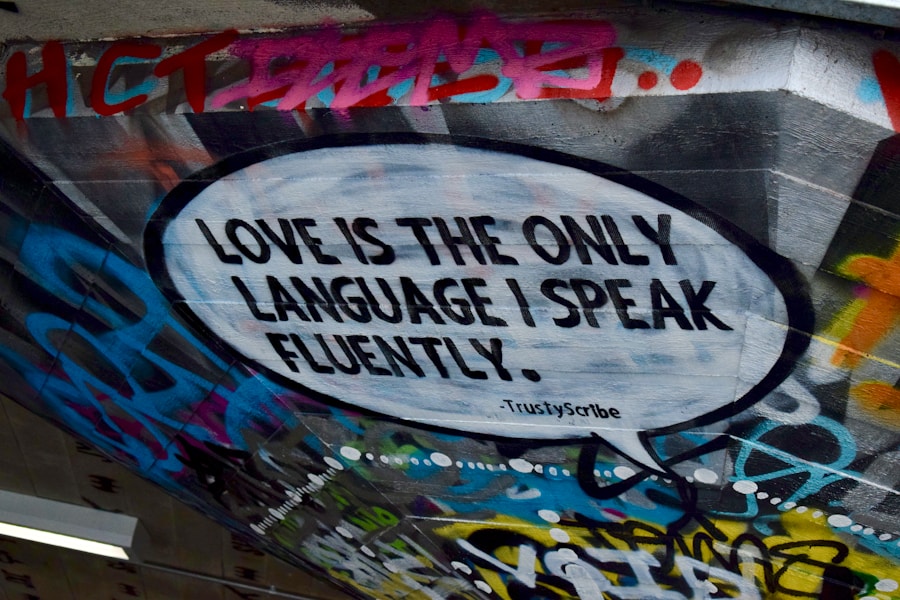
Cultural immersion is a pivotal aspect of language learning that transcends mere vocabulary acquisition and grammatical proficiency. It involves engaging deeply with the cultural contexts in which a language is spoken, allowing learners to experience the nuances and subtleties that define communication within that culture. This immersive approach not only enhances linguistic skills but also fosters a more profound understanding of the social, historical, and emotional layers embedded in language.
For instance, a learner studying Spanish in a classroom setting may grasp the mechanics of verb conjugation, yet without exposure to the cultural significance of certain phrases or idioms, their understanding remains superficial. Moreover, cultural immersion facilitates a more holistic learning experience by connecting learners with the lived experiences of native speakers. When individuals immerse themselves in a culture, they encounter real-life situations that require them to use the language in context.
This could involve participating in local festivals, engaging in community events, or simply conversing with locals in everyday scenarios. Such experiences not only bolster language skills but also cultivate an appreciation for the cultural heritage and values that shape communication styles. For example, understanding the concept of “hygge” in Danish culture can enrich a learner’s grasp of the language by providing insight into the importance of coziness and togetherness in social interactions.
Key Takeaways
- Cultural immersion is crucial for language learning as it provides a deeper understanding of the language and its context.
- Dialogues are an effective tool for cultural immersion as they allow learners to engage in real-life conversations and scenarios.
- Language dialogues help learners explore cultural nuances and understand the context in which the language is used.
- Building empathy and cultural competence is a key benefit of using language dialogues for cultural immersion.
- Cultural immersion helps overcome language barriers by providing a holistic understanding of the language and its cultural context.
Utilizing Dialogues as a Tool for Cultural Immersion
Dialogues serve as an effective tool for cultural immersion, offering learners a dynamic way to engage with both language and culture simultaneously. By analyzing and practicing dialogues that reflect authentic interactions, learners can gain insights into the social norms, values, and expectations that govern communication within a particular culture. For instance, a dialogue set in a French café might include not only the exchange of pleasantries but also the subtleties of politeness and the cultural significance of food and drink in French society.
Such dialogues can be crafted to reflect various scenarios, from casual conversations to formal discussions, thereby providing learners with a comprehensive understanding of how context influences language use. Incorporating dialogues into language learning can also enhance listening and speaking skills. When learners engage with scripted dialogues or role-play scenarios, they practice pronunciation, intonation, and rhythm while simultaneously absorbing cultural references and idiomatic expressions.
This dual focus on language mechanics and cultural context allows for a richer learning experience. For example, a dialogue that explores the topic of family dynamics in Italian culture can introduce learners to specific vocabulary while also highlighting cultural attitudes toward family gatherings and relationships. By immersing themselves in these dialogues, learners not only improve their linguistic abilities but also develop a more nuanced understanding of the cultural backdrop against which the language is spoken.
Exploring Cultural Nuances through Language Dialogues

Language is inherently tied to culture, and exploring cultural nuances through dialogues can illuminate the intricate relationship between the two. Each language carries with it unique expressions, idioms, and phrases that reflect the values and beliefs of its speakers. For instance, in Japanese, the concept of “wa” (和) emphasizes harmony and group cohesion, which is often reflected in conversational styles that prioritize indirectness and politeness.
By engaging with dialogues that incorporate such cultural nuances, learners can better appreciate how language shapes interpersonal relationships and social interactions. Furthermore, dialogues can serve as a lens through which learners can examine cultural practices and traditions. A dialogue centered around a traditional celebration, such as Diwali in India or Thanksgiving in the United States, can provide insights into the significance of these events within their respective cultures.
Through such dialogues, learners not only acquire relevant vocabulary but also gain an understanding of the rituals, customs, and values associated with these celebrations. This exploration of cultural nuances enriches the learning experience by fostering curiosity and encouraging learners to delve deeper into the cultural contexts that inform language use.
Building Empathy and Cultural Competence through Language Dialogues
| Language Dialogues | Empathy Building | Cultural Competence |
|---|---|---|
| Spanish Dialogues | 85% | 90% |
| French Dialogues | 80% | 85% |
| Chinese Dialogues | 75% | 80% |
Engaging with language dialogues can significantly contribute to building empathy and cultural competence among learners. By stepping into the shoes of native speakers through role-playing or scripted interactions, learners can develop a deeper understanding of diverse perspectives and experiences. This empathetic engagement is crucial in today’s interconnected world, where cross-cultural communication is increasingly common.
For example, a dialogue that addresses issues such as immigration or social justice can prompt learners to consider the challenges faced by individuals from different backgrounds, fostering a sense of compassion and awareness. Cultural competence goes beyond mere awareness; it involves actively engaging with and respecting diverse cultures. Dialogues that incorporate real-life scenarios can help learners navigate complex social situations with sensitivity and understanding.
For instance, practicing dialogues that involve negotiating differences or resolving conflicts can equip learners with the skills needed to communicate effectively across cultural boundaries. By developing these competencies through dialogue practice, learners are better prepared to engage meaningfully with individuals from various backgrounds, ultimately contributing to more harmonious interactions in multicultural settings.
Overcoming Language Barriers through Cultural Immersion
Language barriers often pose significant challenges for learners seeking to communicate effectively in a new language. However, cultural immersion can serve as a powerful antidote to these obstacles. By immersing themselves in environments where the target language is spoken, learners are compelled to confront their limitations head-on while simultaneously gaining confidence in their abilities.
For instance, participating in a language exchange program or living with a host family can provide invaluable opportunities for learners to practice their language skills in real-world contexts. Moreover, cultural immersion encourages learners to adopt a growth mindset when it comes to language acquisition. Instead of viewing mistakes as failures, learners come to see them as essential components of the learning process.
Engaging with native speakers in informal settings allows for trial and error without the pressure of formal assessments. This experiential learning approach not only helps learners overcome linguistic hurdles but also fosters resilience and adaptability—qualities that are essential for effective communication across cultures.
Fostering Authentic Connections through Cultural Immersion

Cultural immersion creates pathways for authentic connections between language learners and native speakers. When individuals engage with each other on a personal level—sharing stories, experiences, and cultural insights—they build relationships that transcend linguistic barriers. These connections are often rooted in shared interests or experiences that foster mutual understanding and respect.
For example, participating in community events or local traditions allows learners to connect with native speakers over common values or interests, creating bonds that enhance their language learning journey. Authentic connections also provide learners with opportunities to practice their language skills in meaningful ways. Conversations that arise from genuine interactions are often more engaging and memorable than rote memorization exercises.
When learners discuss topics they are passionate about or share personal anecdotes, they are more likely to retain vocabulary and phrases relevant to those discussions. This organic approach to language learning not only enhances fluency but also deepens cultural understanding by allowing learners to explore diverse perspectives through their interactions.
Embracing Diversity and Inclusivity through Language Dialogues
Language dialogues can serve as powerful tools for embracing diversity and promoting inclusivity within language learning environments.
This approach not only enriches the learning experience but also fosters an environment where all students feel valued and represented.
For instance, dialogues that feature characters from various ethnicities or socio-economic backgrounds can help learners understand different cultural perspectives while also challenging stereotypes. Engaging with diverse narratives encourages critical thinking and empathy among learners as they navigate complex social issues through dialogue practice. Additionally, incorporating multilingual dialogues can further enhance inclusivity by recognizing the linguistic diversity present within classrooms or communities.
By valuing all languages and cultures equally, educators can create an environment where every learner feels empowered to share their unique voice.
Incorporating Cultural Immersion into Language Learning Curriculum
To maximize the benefits of cultural immersion in language learning, it is essential to integrate it thoughtfully into the curriculum. Educators can design lessons that incorporate authentic materials—such as films, music, literature, and news articles—that reflect the culture associated with the target language. These materials can serve as springboards for discussions that explore cultural themes while simultaneously reinforcing language skills.
Additionally, experiential learning opportunities should be woven into the curriculum whenever possible. Field trips to cultural events or partnerships with local organizations can provide students with hands-on experiences that deepen their understanding of the culture they are studying. Language exchanges or virtual pen pal programs can also facilitate meaningful interactions between learners and native speakers, further enriching their educational experience.
This holistic approach ensures that learners emerge not just as proficient speakers but as culturally aware individuals ready to engage meaningfully with diverse communities around them.
If you are interested in using dialogues for cultural immersion in language learning, you may also find the article on dialogue about house cleaning and dialogue about a flat tire may also offer valuable language practice opportunities in different cultural contexts.
FAQs
What is cultural immersion in language learning?
Cultural immersion in language learning refers to the process of fully engaging with the culture of the language being learned. This can include activities such as participating in cultural events, interacting with native speakers, and using authentic materials from the target culture.
How can dialogues be used for cultural immersion in language learning?
Dialogues can be used for cultural immersion in language learning by providing learners with authentic language and cultural context. By listening to and practicing dialogues, learners can gain insight into the way language is used in real-life situations and learn about cultural nuances and customs.
What are the benefits of using dialogues for cultural immersion in language learning?
Using dialogues for cultural immersion in language learning can help learners improve their listening and speaking skills, gain cultural understanding, and build confidence in using the language in real-life situations. It can also make the learning process more engaging and enjoyable.
How can learners find dialogues for cultural immersion in language learning?
Learners can find dialogues for cultural immersion in language learning through various sources such as language textbooks, online language learning platforms, language exchange programs, and cultural events. They can also create their own dialogues based on real-life situations they encounter in the target culture.



